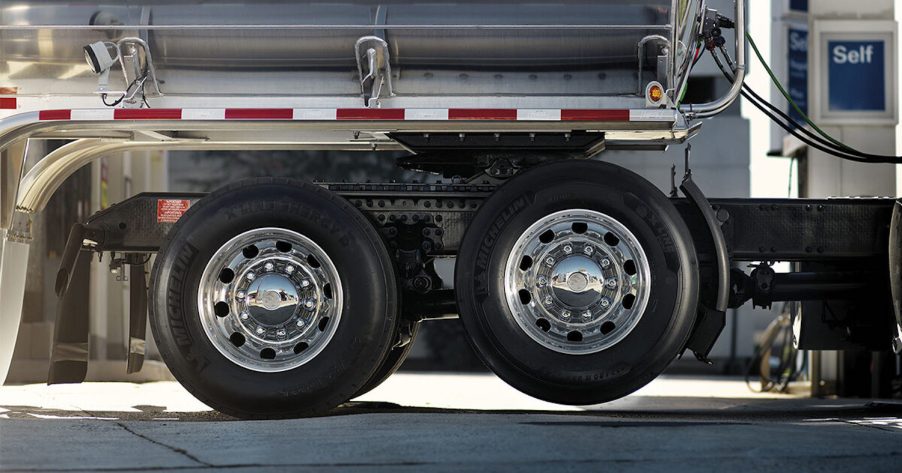
Why Do Some Semi Truck Tires Not Touch The Ground?
Have you ever noticed semi trucks cruising down the road with wheels and tires that don’t even touch the ground? Sometimes they are on an axle suspended below the belly of the truck. Other semi trucks even have an extra axle on the roof! Truck drivers can activate these “drop axles” when heavily loaded or on roads and bridges with weight limitations based on the number of axles a truck has.
Why do semi trucks have elevated wheels?
Some dump trucks and semi trucks have entire axles elevated above the ground. These “drop axles”/”lift axles” can be lowered to the ground to help carry especially heavy loads or meet strict local regulations for weight per axle.

Extra axles can make a truck more difficult to drive. Also more wheels on the ground mean more tires and bearings which will wear out and require replacement. Truck owners and operators would often prefer a vehicle with less axles, each axle rated to carry a higher weight.
But the more weight each truck tire carries, the more pressure it exerts on the road’s surface. The more pressure a road must take, the sooner it wears out. Therefore, the regulators responsible for building and repairing roads do not want individual tires carrying much weight. They want lightly loaded trucks or trucks with more axles.
These contradictory goals have led to an ingenious solution: drop axles. Truck operators can deploy fewer axles while on a sturdier load or not carrying any weight. But regulators can require more axles on smaller roads, delicate bridges, or for heavily loaded trucks.
How do semi truck drop/lift axles work?
Certain semi trucks have axles that can lift up and not touch the ground. These axles leverage adjustable air suspension so the driver can raise or lower them from in the cab.

When these axles are installed in the middle of the truck they are often called drop axles or lift axles–according to the Washington Post. Alternatively, this axle may be located behind the main (driven) rear axles to extend the truck’s wheelbase for regulation issues. In this case it’s often called a tag axle.
All axles that are located under the truck but that can rise up high enough to not touch the ground ride on heavy-duty air suspension. When the truck’s driver deflates the airbags connecting this axle to the truck, the resulting vacuum actually pulls its tires up off the road.
When the driver reinflates these airbags, the pressure lowers the wheels to the ground and lifts the truck slightly. All of these axles take some of the semi truck’s weight off the its other axles.
Are there alternatives to drop/lift axles for semi trucks?
A semi truck without drop/lift axles would either need to have more permanent axles. Alternatively, its driver could carry less weight or avoid smaller roads and bridges with lower weight limits.

Some large, fixed trucks (not semi tractor trailers) have twin steer front ends. This is growing popular for European trucks. This means the truck has two axles up front, all four wheels capable of turning as it goes around a corner. This layout means it can carry more weight without drop/lift axles and the load is better centered between all of its axles.
Drop/lift axles may seem to be overly complicated. But considering the conflicting goals of truck owners and the municipalities they drive through, these flexible axles are an ingenious compromise.
Next, read why semi truck have yellow lights on their roofs or see extra axles in action in the video below:



